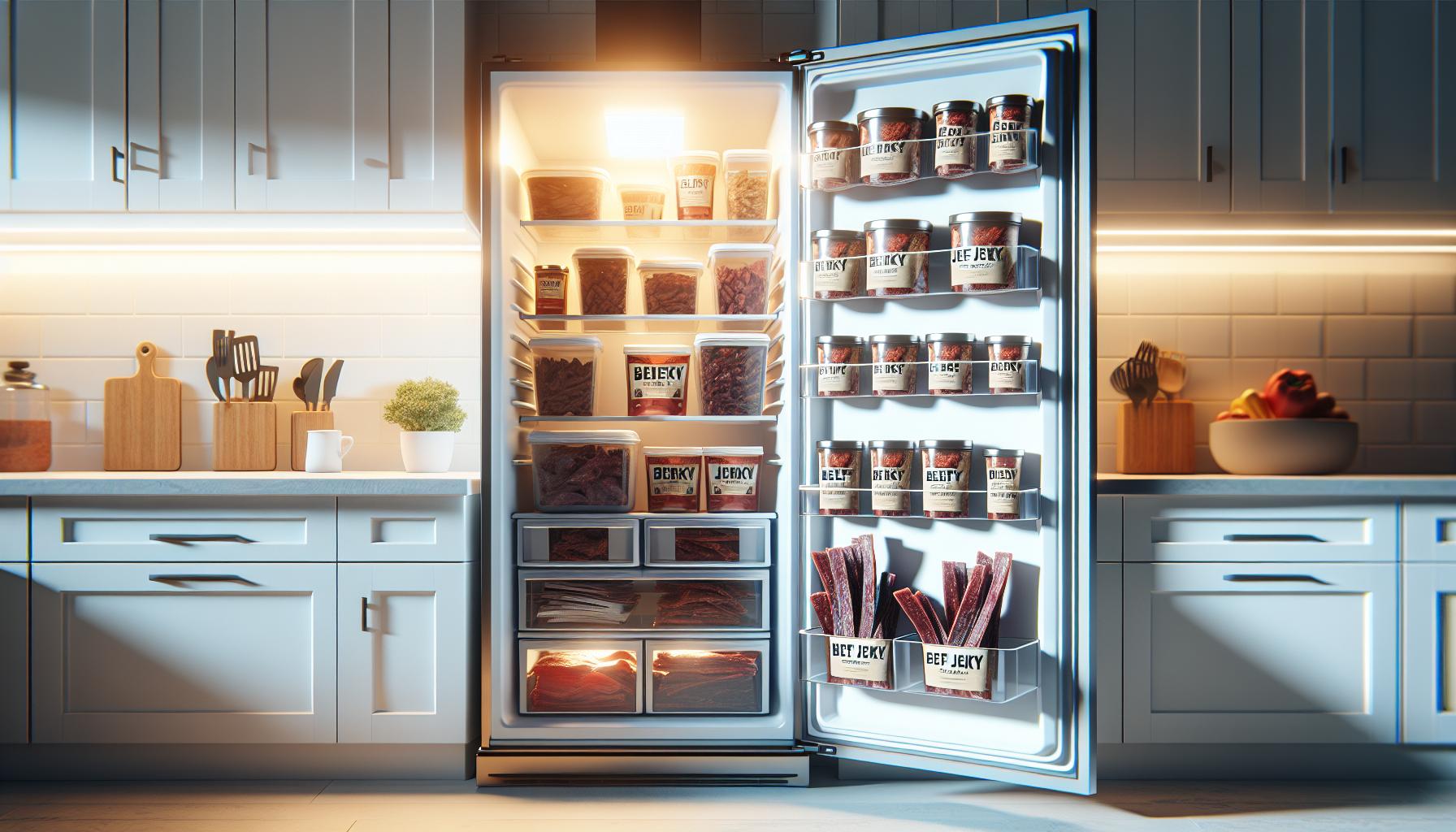Beef jerky is a beloved snack known for its portability and rich flavor, making it a popular choice for outdoor enthusiasts and busy individuals alike. However, it’s important to understand how long this tasty treat can last in the fridge and how to store it properly to maintain its freshness and safety. Many people wonder if their beef jerky has gone bad, and knowing the signs and best practices can help prevent food waste and ensure a satisfying snacking experience.
In this guide, we’ll explore the shelf life of beef jerky in the fridge, providing you with essential tips on storage, temperature control, and safe consumption. By following this freshness guide, you can enjoy your jerky to the fullest while ensuring it remains safe to eat. So, whether you’ve just bought a new batch or have some leftovers, keep reading to discover how to make the most of your beef jerky!
How Long Can You Store Beef Jerky in the Fridge?
The distinctively smoky, savory taste of beef jerky makes it a favorite snack for many. When stored correctly, you can keep this delicious treat in the fridge to preserve its flavor and texture. Typically, beef jerky can last 1 to 2 weeks in the refrigerator. Storing it at this temperature can help maintain freshness longer than at room temperature, where it may only last a few days.
To maximize the shelf life of jerky, it’s crucial to keep it in an airtight container or sealable bag to minimize exposure to air and moisture. Over time, even in the fridge, jerky can lose its prime texture, becoming dry and potentially stale. Always label your container with the date of storage to keep track of how long it has been stored.
Another important factor to consider is the humidity level in your refrigerator. High humidity can prompt mold growth even on dehydrated foods like jerky. Be sure to inspect the environment where you store it, maintaining a cool, dry space to ensure safety and longevity. If you find a jerky package that has not been opened and has a long expiration date, it’s often fine to keep it in the refrigerator until you’re ready to eat.
Factors Affecting Beef Jerky Freshness
The longevity of beef jerky hinges on several key factors, contributing to its freshness and overall quality. Understanding these elements not only helps you enjoy your jerky for longer but also ensures it remains safe for consumption.
One of the primary factors affecting jerky freshness is moisture content. Beef jerky is dehydrated to remove moisture, which inhibits bacterial growth. However, if jerky is exposed to humidity, such as in a refrigerator with high moisture, it can absorb water, leading to potential spoilage. This means keeping jerky stored in a truly airtight container is essential to maintain its dry environment. Even a small amount of moisture can lead to mold growth, which can spoil the jerky quickly.
Temperature also plays a crucial role in preserving jerky. While refrigeration slows down the degradation process, fluctuating temperatures can lead to condensation inside storage containers, promoting spoilage. Moreover, the initial quality of the jerky affects how long it will last. Commercially made jerky often contains preservatives, extending its shelf life compared to homemade varieties, which may lack such additives. When considering storage, always take note of the production date and any expiration guidelines provided on the packaging.
Lastly, the type of packaging significantly impacts jerky’s freshness. Vacuum-sealed packages are ideal because they minimize air exposure, which can lead to oxidation and staleness. Resealable bags or containers with tight seals are beneficial for opened jerky to maintain an optimal environment. If jerky is purchased in bulk, consider dividing it into smaller portions and sealing them separately to help maintain freshness over time. By understanding how moisture, temperature, quality, and packaging affect beef jerky, you can take practical steps to enjoy this tasty snack at its best.
Signs of Spoiled Beef Jerky to Watch For
The quality of beef jerky can degrade over time, and it’s essential to be vigilant for signs of spoilage to ensure your safety and enjoyment. Spoiled beef jerky can have adverse effects if consumed, so recognizing its characteristics is crucial. One of the first things to look for is an off smell. Fresh jerky typically has a savory, meaty aroma, but spoiled jerky may emit a sour or rancid odor that indicates bacterial growth or oxidation.
Another indicator is the jerky’s texture. Properly stored jerky should retain a leathery, firm consistency. If you find that the jerky has become excessively sticky, overly soft, or moist to the touch, it has likely absorbed moisture, creating an environment conducive to spoilage. It’s also worth inspecting the surface; if there are any signs of mold or an unusual film developing on the jerky, it is best to discard it immediately.
Color changes can also be telling. Fresh beef jerky should have a deep, uniform color, while spoiled jerky may appear dull, discolored, or faded. If you notice any gray, green, or brown patches that look abnormal compared to the rest of the jerky, these could be signs of spoilage. Always prioritize safety over consumption; when in doubt, it’s better to err on the side of caution and throw out any questionable jerky.
Regularly checking your beef jerky for these signs can help maintain your safety and enjoyment, ensuring that every bite remains a flavorful experience. Paying close attention to its aroma, texture, color, and any visible signs of spoilage will help you make informed choices about its consumption.
Best Practices for Storing Beef Jerky
Storing beef jerky properly is crucial for maintaining its taste and safety. With the right practices, you can significantly extend its shelf life while ensuring it remains a delightful snack. One core principle to remember is that moisture is the enemy of jerky. Even the most carefully prepared jerky can spoil if exposed to humidity, so keeping a dry environment is essential.
When storing beef jerky, it’s best to use airtight containers or sealed bags. Opt for vacuum-sealed packaging if possible, as this helps eliminate air and moisture that can lead to spoilage. For immediate consumption, keeping jerky in its original packaging is acceptable, but once opened, transferring it to a resealable bag or container will help lock in freshness. Aim to store your jerky in a cool, dark place like a pantry or a cupboard away from direct sunlight.
For those who prefer refrigeration, beef jerky can last longer when stored in the fridge-generally up to 6 months. Ensure it’s well-sealed to prevent the absorption of odors from other foods. If you’re considering freezing your jerky, this is an excellent option for extending its life even further; frozen beef jerky can last for up to a year. Just remember to allow it to defrost in the refrigerator before consumption to maintain its texture and flavor.
Utilizing moisture-absorbing packets or silica gel packs within your storage container can also help in preventing moisture buildup. Be mindful of how you label your jerky storage, especially if you have various types; clear labeling with a date ensures that you consume the oldest first, reducing waste and maintaining your enjoyment of every bite. Following these best practices will ensure your jerky remains a safe and satisfying treat for many months.
How to Extend the Shelf Life of Beef Jerky
To ensure that beef jerky remains fresh and enjoyable for as long as possible, consider implementing a few scientific and practical storage methods. Moisture is the enemy of jerky; thus, when it comes to extending its shelf life, maintaining a dry environment is crucial. Properly sealed packaging is your first line of defense. Using airtight containers or vacuum-sealed bags significantly reduces the chances of moisture penetrating the jerky, thereby preventing spoilage.
Utilizing Refrigeration
Storing your beef jerky in the refrigerator can significantly enhance its longevity. When kept sealed and stored in the fridge, jerky can last up to six months without compromising quality. It’s important to place your jerky in a container that doesn’t absorb odors from other foods. For optimal flavor preservation, ensure that the container is not only airtight but also permits no moisture infiltration.
Freezing for Extended Freshness
If you want to keep your beef jerky for an even longer period, freezing is an excellent option. When frozen properly, beef jerky can last up to one year. To freeze it without damaging its texture, seal the jerky in a vacuum-friendly bag or an airtight container, ensuring that as much air as possible is removed. Always allow the jerky to thaw in the refrigerator before consuming, as this will help maintain its best flavor and consistency.
Moisture Control Techniques
Incorporating moisture-absorbing packets or silica gel packs into your storage containers can help maintain an ideal moisture level and extend shelf life. Clear labeling with the purchase or opening date can prevent confusion and help you consume the oldest stock first, minimizing waste. This proactive approach not only extends the usability of your beef jerky but also ensures you continually enjoy it at its peak freshness.
Implementing these strategies can significantly enhance the lifespan of your beef jerky, allowing you to savor its rich flavors while also being assured of its safety over time.
Types of Beef Jerky and Their Storage Needs
When it comes to beef jerky, various types offer unique flavors and textures, but they also come with specific storage needs to maintain their quality and safety. Understanding the distinctions between homemade and store-bought jerky, as well as the different flavor profiles available, can help you make informed choices about how to store each type effectively.
Homemade beef jerky, often made with marinated lean cuts of meat, allows for customization but typically has a shorter shelf life. When stored in the fridge, homemade jerky can last about one to three months. The absence of commercial preservatives in homemade varieties means they are more susceptible to spoilage, so proper storage in an airtight bag or container is essential. For those making jerky at home, using moisture-absorbing packets can help extend shelf life by keeping the environment dry.
Store-bought jerky, on the other hand, is generally more shelf-stable due to the preservatives included during the packaging process. Most commercially produced jerky can sit in the pantry for up to a year before opening. Once opened, it’s best to transfer it to a sealed container and refrigerate it, where it can remain fresh for up to six months. Be sure to check the packaging for any specific storage instructions, as some brands may have particular recommendations to preserve freshness in line with their unique ingredients.
In addition to traditional beef jerky, there are now various specialized types, including teriyaki, spicy, and sweet flavors, which may impact their storage as well. Spicy varieties, for example, may be a bit more resilient to spoilage due to the presence of preservatives like sodium. However, the essence of keeping all forms of jerky fresh hinges on controlling moisture and storing in a cool, dark place. Ultimately, understanding the type of jerky you have will help you choose the best method for storage, ensuring you enjoy savory bites for as long as possible.
Homemade vs. Store-Bought Beef Jerky Storage
Homemade beef jerky can be a rewarding snack, allowing you to personalize flavors and control the ingredients. However, it typically has a noticeably shorter shelf life than store-bought options. When stored in the fridge, homemade jerky generally lasts one to three months. This reduced longevity stems from the absence of preservatives, making it more vulnerable to mold and spoilage. To maximize freshness, it’s crucial to keep homemade jerky in an airtight bag or container. Including moisture-absorbing packets can also help by creating a drier environment, which is essential for preserving quality.
In contrast, store-bought jerky benefits from commercial preservation techniques, enabling it to maintain its quality over time. Once sealed, many brands can remain fresh in the pantry for as long as a year. After opening, transferring the jerky to a sealed container and refrigerating it can extend its life for an additional up to six months. This kind of jerky often contains additional sodium and other preservatives, which enhance its resistance to spoilage. Be sure to check the specific storage instructions on the packaging, as various brands may differ in their recommendations based on the ingredients used.
Choosing between homemade and store-bought jerky involves a balance of flavor preference and convenience. While homemade jerky allows for dietary customization and creative flavor combinations, it requires more diligent storage practices. Store-bought jerky, while typically easier to store, may offer less flexibility in terms of flavor and additives. Regardless of which option you prefer, understanding the storage needs and lifespan can ensure that you always have safe, delicious jerky on hand when cravings strike. Properly managing the storage conditions will help keep your jerky as fresh and flavorful as when it was made or purchased.
Can You Freeze Beef Jerky for Longer Life?
To extend the life of your beef jerky, freezing is an excellent option that many people overlook. Freezing not only preserves the savory flavor of the jerky but also protects it from spoilage, allowing you to enjoy your favorite snack long after its original shelf life. When properly managed, frozen beef jerky can stay safe for consumption for several months, typically up to a year, without a significant loss in quality or taste.
Before freezing, ensure the beef jerky is sealed tightly. An airtight container or a vacuum-sealed bag is ideal for preventing freezer burn, which can affect the texture and flavor. If you’re using a standard zip-top bag, try to remove as much air as possible before sealing. After packaging, label the container or bag with the freeze date so you can keep track of how long it has been stored.
When you’re ready to enjoy the frozen jerky, simply transfer it to the refrigerator for a few hours or overnight to thaw. Avoid defrosting it at room temperature to reduce the risk of bacterial growth. Once thawed, consume the jerky within a week for the best taste and texture, keeping in mind that it should not be refrozen after it has been thawed. Following these guidelines not only guarantees a satisfying snack but also reinforces food safety practices, ensuring that your jerky maintains its delicious appeal over time.
Impact of Packaging on Jerky Longevity
The packaging of beef jerky plays a crucial role in its shelf life, impacting both freshness and safety. Proper packaging can significantly inhibit the growth of bacteria and mold, while also preventing moisture and air exposure, which can lead to spoilage. For optimal results, consider using vacuum-sealed bags or airtight containers. These methods not only minimize air contact but also restrict humidity, which is essential because moisture is a primary enemy of jerky longevity.
When buying commercially packaged jerky, always check for a “best by” date. However, note that these dates are often conservative; many types of jerky can remain enjoyable for some time beyond the printed date when stored correctly. Homemade jerky, on the other hand, may have shorter shelf life due to the absence of preservatives typically found in store-bought variations. For homemade jerky, it’s recommended to store it in glass jars or heavy-duty resealable bags to maximize freshness.
Moreover, using clear packaging materials can make it easy to inspect your jerky at a glance. If the jerky changes color or loses its aroma, those are signs that it may have aged past its prime. Always ensure your jerky is sealed tightly, as any exposure to air can promote rancidity and degradation of flavor. For additional protection, you might consider adding desiccant packs to the container, which absorb leftover moisture and help maintain a crisp texture.
In conclusion, the is significant. By choosing the right type of packaging and regularly examining your jerky, you can enjoy this delicious snack for as long as possible while keeping it safe and fresh. Prioritize airtight seals, pay attention to storage conditions, and remember that well-packaged jerky is your best bet for maintaining its quality.
How to Safely Enjoy Jerky Past Its Prime
As jerky ages, it may lose some of its prime quality, but don’t let that deter you from enjoying it. Knowing how to recognize the state of your jerky and ensure its safety can extend your enjoyment even beyond its “best by” date. If stored properly, many types of jerky can still offer a decent taste, whereas others might require some creative approaches to enhance their flavor and texture.
First, assess the jerky’s appearance and smell. If it shows minor changes in color or has a slightly off aroma, it’s likely still safe to consume. However, if there’s significant discoloration, excessive dryness, or a rancid smell, it’s better to err on the side of caution and discard it. One simple way to revitalize older jerky is to rehydrate it lightly. Placing it in a sealed container with a damp paper towel for a few hours can help restore some moisture, making it more enjoyable to chew.
For those who want to be adventurous, consider using aged jerky as an ingredient rather than a standalone snack. Chopping it into smaller pieces and adding it to soups, stews, or salads can impart a unique flavor without compromising safety. Just be mindful of the overall dish’s salt content, as jerky is often high in sodium. Also, mixing older jerky into a marinade can help reintroduce moisture while flavoring meats or vegetables.
Ultimately, the key is to trust your instincts while recognizing the signs of quality deterioration. Staying informed about the boundaries of food safety can empower you to use your jerky creatively, ensuring you don’t waste a single delicious morsel, even when it’s past its peak.
Common Myths About Beef Jerky Shelf Life
Many people enjoy beef jerky not just for its flavor but also for its presumed shelf stability. However, there are several misconceptions surrounding the longevity of this popular snack, which can lead to confusion about safety and quality. One common myth is that beef jerky can last indefinitely as long as it’s kept sealed. In reality, while properly packaged beef jerky can last a long time, it does have a shelf life influenced by factors like moisture, exposure to air, and temperature variations.
Another widespread belief is that beef jerky does not require refrigeration. While it’s true that many commercial brands are designed to be shelf-stable when unopened, once you break the seal, refrigeration is advisable to maintain optimal freshness. In the fridge, beef jerky typically lasts about one to two months, whereas stored in a pantry, it may become stale or lose flavor after a few weeks. It’s also important to note that the freshness of beef jerky can diminish even more rapidly in warmer environments, emphasizing the need for proper storage conditions.
Many consumers think that all signs of discoloration or odor indicate that their beef jerky has gone bad. While significant changes may indeed signify spoilage, minor variances in color or aroma can occur naturally over time and may not affect the safety of the product. The key is to assess the jerky carefully. If it shows extreme dryness, excessive fat separation, or a rancid smell, it’s best to discard it.
While some people believe that homemade jerky is safer and lasts longer than store-bought varieties, the opposite can often be true. Home preparation methods vary widely and may not include the preservative methods that commercial jerky undergoes. If you’re making jerky at home, ensure you use vacuum-sealing techniques and refrigerate promptly to preserve its quality.
Understanding these myths enables you to enjoy your beef jerky responsibly and to gauge its safety better. Adopting good storage practices and being aware of its actual shelf-life are essential steps for maximizing both taste and safety.
Frequently asked questions
Q: How can I tell if beef jerky is expired?
A: To determine if beef jerky is expired, check for changes in color, smell, and texture. Spoiled jerky may have a sour odor, be overly dry or damp, and exhibit mold. Always adhere to the best before date and evaluate before consumption.
Q: What is the best way to store beef jerky?
A: The best way to store beef jerky is in an airtight container in a cool, dark place, like the fridge. This method helps maintain freshness and flavor. You can also vacuum seal it to extend its shelf life significantly.
Q: Can I eat beef jerky after the expiration date?
A: You can eat beef jerky after the expiration date if it shows no signs of spoilage, such as odors, mold, or unusual texture. However, for safety, always prioritize proper storage practices and heed food safety guidelines.
Q: Does homemade beef jerky last longer than store-bought?
A: Homemade beef jerky may not last as long as store-bought jerky due to differences in preservatives. Typically, homemade jerky should be consumed within a week or two when refrigerated, while store-bought can last up to several months.
Q: How long can opened beef jerky last in the fridge?
A: Opened beef jerky can last about 1 to 2 weeks in the fridge when stored in an airtight container. Always check for signs of spoilage to ensure it’s still safe to eat.
Q: Is it safe to eat beef jerky with a soft texture?
A: No, it is not safe to eat beef jerky with a soft or sticky texture, as this can indicate moisture infiltration, leading to spoilage. Ensure your jerky maintains a firm texture for optimal safety.
Q: How should I thaw frozen beef jerky?
A: To thaw frozen beef jerky, place it in the refrigerator overnight or use a microwave on a low setting. Avoid leaving it at room temperature to prevent bacterial growth. Properly storing it can help it last significantly longer.
Q: What factors influence the shelf life of beef jerky?
A: Factors influencing the shelf life of beef jerky include moisture content, storage temperature, packaging, and the presence of preservatives. Proper storage and vacuum sealing can help maximize its freshness [2[2].
Future Outlook
In summary, understanding how long beef jerky lasts in the fridge is essential for maintaining its quality and safety. Remember, properly stored beef jerky can remain fresh for up to one week in the refrigerator, but keeping an eye on its appearance and smell is crucial. Don’t let uncertainty hold you back-check your jerky regularly and enjoy it at its best!
For more insights on preserving your favorite snacks, explore our guides on “Best Practices for Storing Dried Meats” and “Food Safety Tips for Homemade Jerky.” If you found this guide helpful, consider signing up for our newsletter for more expert tips and recipe ideas. Have questions or stories about your jerky experiences? We’d love to hear from you in the comments below! Your next culinary adventure awaits-let’s keep exploring together!





